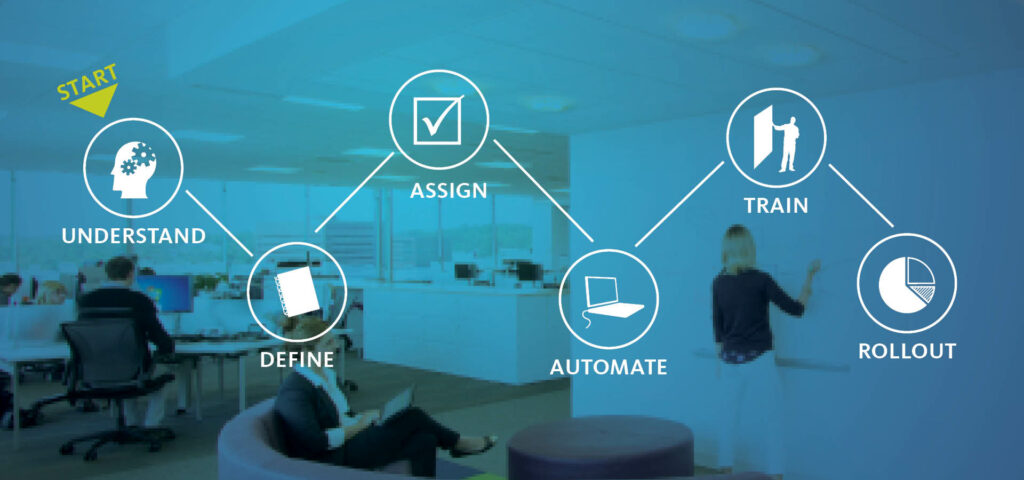If a constant shuffling of desks in your workplace seems like it’s become the new norm, you’re not alone.
Managing office moves and tracking the supply and demand of space is critical for reacting to business demands quickly and efficiently. Reporting on multiple dimensions of the workplace—vacancy, occupancy ratios, space efficiency, etc. is impacted by maintaining accurate data within a space management system.
With data as a driving force for decision making in today’s workplace, corporate real estate and facilities professionals are expected to be able to add data-driven insights to questions such as:
- What is the current supply and demand of space?
- How can we use space more efficiently?
- How can we improve departmental collaboration?
- Which spaces are most sought after by employees?
A byproduct of desk churn is its impact on data integrity within space and move management systems. Office seating plans and occupancy data can quickly become out of date.
“Data is stale in a week, that’s how it goes in space planning: It needs to be immediate.”
— Vice President of Corporate Real Estate, Banking and Financial Services Firm
Understanding desk churn in the workplace
![]() Desk churn measures the number of times somebody is reassigned from one seat to another—also known as box moves. Box moves are often in response to a business need such as reorganizations, growth or reduction in staff, and transfers.
Desk churn measures the number of times somebody is reassigned from one seat to another—also known as box moves. Box moves are often in response to a business need such as reorganizations, growth or reduction in staff, and transfers.
For many organizations, desk churn may simply be a result of necessary departmental and desk moves to accommodate changing headcounts and occupancy needs, but there is a growing trend of strategic desk churn in which high desk churn isn’t necessarily a negative thing.
Some organizations intentionally have upwards of 400% desk churn or more by scheduling quarterly all-employee desk moves. Some benefits of this include:
- Encouraging new connections by changing the proximity between different departments and employees.
- Infusing creativity with a change of scenery or association with new collaborators.
- Instilling fairness in the seating assignments, such as rotating who gets coveted window seating.
- Aligning teams differently based on project assignments.
Another culprit of desk churn is the “midnight move,” when occupants move into a new station without telling anyone. If you’ve ever been a victim of this, you’ve experienced how quickly seating plans become obsolete and data integrity within a space management software becomes dated.
The value of maintaining accurate occupancy data

“When accurate data is available, invitations to the decision-making table increase. This proactive approach can move a business into strategy and action more quickly.”
— Christi Van Maanen, Senior Associate, Gensler
It all starts with a thoughtful move management process and occupancy tracking. By maintaining accurate data, you’ll be able to:
- Provide hard, irrefutable data to support a workplace strategy and/or test a hypothesis about occupancy.
- Verify current standards/benchmarks and space allocation metrics in the early stages of programming.
- Optimize a space to better suit the needs of the users.
- Determine departments for mobile readiness and consider the implementation of seat sharing as part of a mobility strategy.
- Identify opportunities to save space by consolidating leases.
- Publish accurate wayfinding maps of your workplace.
6 Simple Steps to Optimize Your Move Management Process and Increase Data Integrity In Your Space Management Software.
Improving office seating plans and occupancy data begins and ends with streamlined move, add, change management. Our tried and true steps will help you implement a streamlined MAC process that will add value to organizations of any size.
These are the same steps that we work through with our clients on when implementing Wisp, and now you can apply them to your organization. Whether a workplace portfolio is 30,000 or 30 million square-feet, these industry best practices can be right-sized for any organization, resulting in accurate and insightful data.
Move, Add, Change (MAC) Definition
Also know as MAC or move management, these general terms are used when an occupant is reassigned from one workspace to another to another, or when a new hire is onboarded and assigned.
1. Understand the current move management process

Start this process as an investigation. Find out as much as you can about how the process is taking place today. Grab a pen and paper and physically map this out with your team.
- Map out who the key people are, how they are involved, and what information is being transferred.
- Identify what is working well and what isn’t.
- Don’t fix something that isn’t broken.
2. Define the ideal move management process
This is all about working smarter, not harder. In this step you’ll outline the entire ideal move management process and identify ways to eliminate redundancies, such as duplicate data entry, and establish consistency.
- Are there redundant activities that multiple people are doing?
- Is there a standard process for communication?
- Is there documentation or a move management form?
- Is there a clear communication hierarchy and path?
3. Assign key roles to the move, add, change process
Once you’ve explored the current process, identified areas for improvement and mapped out the ideal future state, it’s time to assign key roles and responsibilities. There are three roles that we recommend for keeping data current, although in some organizations only the Requester and Completer may be needed.
Requester
These are people closest to the need for a move request to occur. They may be a department coordinator, department admin, or supervisor.
-
- The requester starts the process by identifying a need.
- Documentation, such as an office move request form, should be completed.
- There should be one requester within each line of business.
Approver
Depending on the process, there may be someone reviewing the move, add, change request form prior to it moving forward. This role is typically a supervisor or manager.
-
- This is an optional role.
- They have the ability to deny the request.
Completer
Typically, this role oversees all governance of the process and helps enforce that it is carried out correctly. There could be one completer per building, or one per several buildings, depending on size. This role is typically filled by facilities or a site coordinator who is responsible for:
-
- Ensuring that the space is available and ready for someone to move into.
- Typically they are the ones that help coordinate the physical move.
- Recording the change accurately in the move management software.
Tip: Some organizations find it works best for them to have only two roles: Requester and Completer.
4. Automate with move management software
 There are many tools available to automate tedious manual tasks and move forms, such as, space management software and office move management software. In Wisp, the change request system automates communication between teams as requests move through the workflow.
There are many tools available to automate tedious manual tasks and move forms, such as, space management software and office move management software. In Wisp, the change request system automates communication between teams as requests move through the workflow.
When your process has been outlined, consider automating these tasks:
- Data exchanges, including an automated daily occupant data import or location information. This keeps data current in your system.
- E-mail notifications can be triggered to streamline communications.
- Move sheets can be generated outlining the details of each occupant that is moving.
“With more and more millennials entering the workforce, this is perfect time to roll out automation. If there is a chance to remove paper forms and automate, they are all for it.”
– Shawn Biven, Senior Property Manager at ADP
5. Train participants and prepare to manage the change
When introducing new roles in the move, add, change process, there is sometimes fear of information getting “messed up” by opening the system to more users.
On the contrary, we’ve found that opening the system to others helps keep data more accurate. By empowering people on the ground to make requests, data remains updated as churn occurs.
As you begin to train others on the new process, keep in mind these change management tips to encourage adherence to the new process:
- Recognize and reward success.
- Enforce positive incentives, not penalties.
- Provide praise and spotlighting from leaders.
- Stay positive and hold the line.
6. Rollout the new move management process
When the process is finalized, it’s time to test it and create a rollout plan to streamline it across all locations with these recommended steps:
- Start with a pilot.
- Fine tune.
- Use a phased rollout approach.
- Conduct post-launch follow-up.
Ongoing: Track and improve over time
With the new process rolled out and the right tools implemented, you’ll have access to the data and information you need at all phases of the real estate life cycle. But the work doesn’t stop. The process needs ongoing ownership, attention, enforcement, and nurturing.
In organizations with multiple locations, it is especially important to determine a cadence for ongoing communication between the teams on the ground.
For one client, consistency and accountability is achieved through monthly standing calls that keep key contributors in close communication to discuss challenges and solutions.
Client Story: An improved process leads to data integrity
 One Wisp client was experiencing a 62% churn desk rate. With a global portfolio of approximately 160 buildings, over seven million square feet, and 40,000+ occupants, it was a struggle to maintain accurate occupancy data. All of the internal movement totaled 25,000 opportunities for data to become outdated as occupants moved desks within the company.
One Wisp client was experiencing a 62% churn desk rate. With a global portfolio of approximately 160 buildings, over seven million square feet, and 40,000+ occupants, it was a struggle to maintain accurate occupancy data. All of the internal movement totaled 25,000 opportunities for data to become outdated as occupants moved desks within the company.
Midnight moves were a frequent occurrence and manual move forms couldn’t keep up. Walk audits were frequently needed to verify seating assignments. Each site was operating independently, resulting in inconsistent processes and unreliable data in the space management software.
To improve the process, we worked with the real estate and facilities team to first understand the current workflow. Roles were then identified to support their portfolio structure—this included an admin as the “requester” and the site coordinator as the “completer”.
With the new process outlined, tools for automation were then introduced. Using the Space Request Utility, admins submit requests, and the site coordinators review and approve the requests. With moves in the queue, a move sheet can simply be exported and provided to the move team.
After a move is complete, the site coordinator completes the request within Wisp, thus maintaining a current inventory of people and space data.
The improved process and interactive tools have ensured that the appropriate roles have the ability to submit requests. It has eliminated the need for dual entry of move requests, and communications have been streamlined with automatic e-mail notifications and move sheets—saving significant time.
Most importantly, it is a proactive approach to keeping the data accurate.
Streamlining the office move management process is an opportunity to bring awareness to the importance of occupancy data and create transparency into the processes which can support data governance, strengthen communication and add value through accurate real estate metrics.
If you’re challenged with the following questions, it may be time to makeover your move management process.
- What is the current supply and demand of space?
- How can we use space more efficiently?
- How can we improve departmental collaboration?
- Which spaces are most sought after by employees?
- How do we align communication across departments?
- How do we streamline our processes in all offices?
- How can I keep up as our portfolio grows?
Our team can help consult on this process, and it’s part of our standard implementation process. Schedule a demo to learn more about how Wisp can support your space and move management goals.



 Desk churn measures the number of times somebody is reassigned from one seat to another—also known as box moves. Box moves are often in response to a business need such as reorganizations, growth or reduction in staff, and transfers.
Desk churn measures the number of times somebody is reassigned from one seat to another—also known as box moves. Box moves are often in response to a business need such as reorganizations, growth or reduction in staff, and transfers.